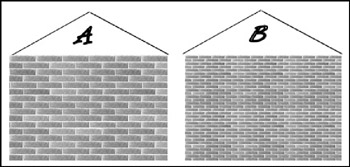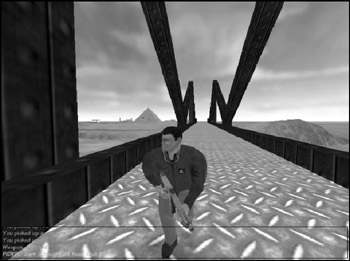Scaling Issues
When creating your textures, you will need to pay attention to the issue of scale. The sizes of the things within an image that is used to make a texture have a particular relationship to other real-world objects. We are subconsciously aware of many of these relationships from our exposure to the world in general and will notice when the textures are out of proportion to the items they adorn. If it's bad enough the effect can sometimes be similar to the sound of fingernails being dragged across a chalkboard!
Figure 11.13 shows two stylized houses. The bricks in house A are far too large, while the bricks in house B are more appropriately sized, yet may still be a bit too large. Yes, there are some uses for stone blocks having proportions such as those in house A, but they are rarely used in bungalow-sized or two-story homes, as depicted in the figure.

Figure 11.13: Scaling bricks.
The scale issue can pop up anywhere, as you can see in Figure 11.14. The texture image in the corrugated metal bridge surface is probably about 10 times larger than is appropriate. Sometimes you might need to redo the texture to match—other times you can adjust how the texture is applied to the polygons using the modeling tools. My rule of thumb is that if the texture image size is 64 pixels by 64 pixels or smaller and needs to be made larger, you should make a new texture at the larger size. The same goes the other way: If the image size is larger than 64 pixels by 64 pixels and needs to be made smaller, then make a new texture at the smaller size.

Figure 11.14: Scaling error.
EAN: 2147483647
Pages: 197